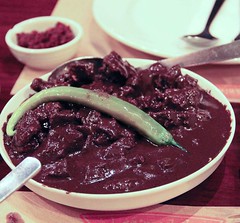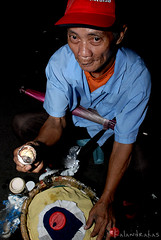You cannot say you’ve been in the Philippines unless you have tried at least one of these 10 most exotic foods served across the country. Some of them are served quite obviously. You can tell by the look of it if it’s a dish you’ve already tried, are willing to try, or you won’t ever dare to. Others, though, look like a regular dish, such as those cooked in “adobo” style — a very prominent cooking method in the Philippines wherein the meat is soaked in vinegar, soy sauce and other seasonings and later sautéed in the marinade. Find out what these dishes are and decide early on if you want to pass or would you rather tickle your taste buds and satiate your adventurous appetite with Philippines most shocking exotic foods.
Rats
I’m not talking about the grubby rats from sewers. I’m referring to those found in the rice fields. They are clean and safe to eat since they feed on rice. Locals would cook them by first skinning them, cutting the head, tail, and legs, removing the innards, and then cooking them by deep-frying, or “adobo” style. If you want to taste “Pritong Dagang Bukid” (crispy, fried rice field rat) or “Adobong Daga” you may find them in distant provinces bespattered with rice fields. As for the taste, as many would always say, it tastes like chicken.
Frogs
Just like rice-field rats, frogs from rice paddies are the ones to taste. But compared to rats, frogs are much more available that they are sold even in the urban wet markets. Some Filipinos cook them and make an “Adobong Palaka.” The Province of Pampanga serves another frog dish called “Betute Tugak,” which is a frog stuffed with minced pork and deep-fried. Others fry and dub them as “Pritong Palaka” (fried frogs) served hot with an appetizing dipping sauce made from soy sauce, chili and citrus juice.
Snakes
Snakes end up on the dining table of the Filipinos as a tasty dish called “Adobong Ahas” (snake adobo) primarily because of the curative and aphrodisiac effects of snakes as some local folks believe. Just like most dishes cooked in “adobo,” the snake meat is cut to about an inch length, skinned and marinated in garlic, vinegar, soy sauce and seasonings. Once you see it, you probably won’t recognize that a snake meat is served — unless, of course, you knew that “ahas” is the Tagalog word for snake.

Monitor lizards
If you’re not familiar with a monitor lizard, then, just think of a gigantic lizard. Adobong Bayawak (or monitor lizard adobo) is cooked by sautéing the meat in garlic and its marinade, and served as a “pulutan” (an appetizing side dish while drinking beer).
Insects
Insects, such as salagubang (beetles), tipaklong (grasshoppers), balang (locusts) and kamaro (mole crickets), are fried or sautéed until brown in color to become a scrumptious, crunchy exotic pulutan. They are a popular dish in Pampanga province. Beetles are usually found in mango trees whereas grasshoppers and locusts in the rice fields. The mole crickets hid beneath the soil, therefore, are caught by stomping at the soil to make them leap out. Another exotic delicacy is the buttered ant eggs, which are the “caviar” of the locals of Bangui, Ilocos Norte. Eaten raw, the ant eggs are deliciously crispy and then creamy in the inside.
Bats
Paniki, particularly the fruit bats, are an exotic delicacy in certain provinces of the Philippines. The meat is also cooked in adobo but with an additional coconut milk. These bats feed on various overripe fruits on trees. Since their number is quickly becoming scarce, hunting them down for food may soon be stopped to conserve them.
Wood worms
Tamilok or wood worms are not exactly a worm but a mollusk. They typically hide and feed on rotten woods and trees. Since they are about eight inches long, they are usually chopped and cooked by deep frying or, as you might already guess, in “adobo” style. In Mindanao provinces like Davao, Agusan, and Surigao, they are eaten raw. A tamilok buff would love it washed, dashed with lemon, and eaten raw for the tingling sensation the wood worm brings through the gut.

Blood
Perhaps you might have already seen a stew that is meaty and dark chocolate in color. Your friends may have tricked you into eating it by saying it’s a chocolate stew. But you might be surprised because amidst the mélange of salty, sour and bitter tastes, you’ll find nothing sweet about it. It’s because it’s not made from dark chocolate but from the blood of the pork (or chicken), which is the key ingredient in this popular Filipino dish called Dinuguan (blood stew).
Balut
Balut is a hard-boiled duck egg. You might wonder what’s so extraordinary or exotic about a hard-boiled egg. Try to crack the egg open and you’ll discover what many people describe as the “duck that never was.” The duck embryo is still there, with the rest of the egg parts like yolk, egg white, membranes and fluids. If you are an embryo enthusiast, consider yourself lucky when the duck embryo is large enough that you can easily recognize its beak, wings, eyes and feet while you eat it. But if not, I’d recommend that the way to eat balut is by first removing the top shell, sip the fluids, season it with a bit of salt and vinegar, then eat the embryo whole. Just don’t mind the few feathers that might tickle your taste buds. Balut is sold everywhere. Listen to the vendors with baskets, walking at night ostentatiously with a holler, “baluuuuuuut!”

Street foods
Why would I include street foods in my list? It’s because, apart from pork and chicken meat, innards and other parts are cooked by grilling them over a coal. Some of the common street foods with interesting colloquial names include:
*Adidas – barbecued chicken feet
*Betamax – barbecued chicken coagulated blood cubes
*Isaw – barbecued chicken intestines
*Helmet – barbecued chicken heads
If you want to give these exotic foods a shot, then come visit the country and try them. They are served in small-town eateries along main roads as well as in some urbane restaurants, such as in Exotik Restaurant in Laguna, Diorama Restaurant in EDSA, and Okavango in Marikina, Rizal.



